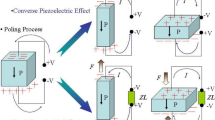Abstract
We investigated how the applied electric-field’s magnitude and the poling time affected, respectively, the dielectric property and the microstructure of piezoelectric lead zirconate titanate/lead zirconate nickel niobate (PZT-PZNN) thick films in order to apply the films to piezoelectric energy harvesters. Several 300-µm-thick, 10 × 10-mm2 PZT-PZNN squares were tape cast, laminated, sintered, and poled under 2-, 4-, 6-, 10-, 14-, and 15-kV/mm electric fields for 30 min. The 10-kV/mm electric field produced the highest d 33 × g 33 without mechanically damaging the sample. Further, samples were sintered at 950, 1000, and 1020 °C and subsequently poled at 10 kV/mm (previously determined as the magnitude of the optimal poling electric field) for 15, 30, 60, 120, and 240 min to investigate how the poling time affected the piezoelectric ceramic’s microstructure. The optimal poling time for all the sintered samples was 60 min. Further, the piezoelectric ceramics composed of small grains and poled longer than 60 min showed higher dielectric constants. However, those composed of large grains and poled for times shorter than 60 min showed higher dielectric constants because the element mobility of the piezoelectric ceramics increased with increasing poling time.
Similar content being viewed by others
References
J. Rocha, L. Goncalves, P. Rocha, M. Silva and S. Lanceros-Mendez, IEEE Trans. Indust. Electron. 57, 813 (2010).
D. Song, H. Jang, S. Kim, C. Yang, M. Woo, S. Hong, J. Lee and T. Sung, J. Electroceram. 31, 1 (2013).
D. Song, H. Jang, S. Kim and T. Sung, J. Electroceram. 31, 35 (2013).
D. Song, C. Yang, S. Hong, S. Kim, M. Woo and T. Sung, Ferroelectrics 449, 11 (2013).
S. Roundy and P. Wright, Smart Mater. Struct. 13, 1131 (2004).
H. Jung, D. Song, S. Hong, Y. Song and T. Sung, Jpn J. Appl. Phys. 52, 10MB03 (2013).
S. Pryia, C. Chen, D. Fye and J. Zahnd, Jpn J. Appl. Phys. 44, L104 (2005).
M. Lee, C. Y. Chen, S. Wang, S. N. Cha, Y. J. Park, J. M. Kim, L. J. Chou and Z. L. Wang, Adv. Mater. 24, 1759 (2012).
S. Saadon and O. Sidek, Energy Conver. and Manage. 52, 500 (2011).
N. E. Toit, B. L. Wardle and S. G. Kim, Integ. Ferroelect. 71, 121 (2005).
L. Gu, Microelect. J. 42, 277 (2011).
V. Walter, P. Delobell, P. L. Moal, E. Joseph and M. Collet, Sensors and Actuators A 96, 157 (2002).
S. Gebhardt et al., J. European Ceram. Soc. 24, 1101 (2004).
S. L. Dren, L. Simon, P. Gonnard, M. Troccaz and A. Nicolas, Mater. Res. Bull. 35, 2037 (2000).
S. Gebhardt, L. Seffner, F. Schlenkrich and A. Schonecker, J. European Ceram. Soc. 27, 4177 (2007).
N. Jaitanong and A. Chaipanich, Ferroelectric Lett. 35, 17 (2008).
F. X. Li and D. N. Fang, Acta Materialia 53, 2665 (2005).
T. M. Kamel and G. de With, J. European Ceram. Soc. 28, 851 (2008).
Z. Li, B. Dong and D. Zhang, Cement & Conc. Compos. 27, 27 (2005).
Y. Takahiro, K. Masako and S. Norikazu, J. Mat. Sci: Mater. Electron. 11, 425 (2000).
Q. Xu, S. Wu, S. Chen, W. Chen, J. Lee, J. Zhou, H. Sun and Y. Li, Mater. Res. Bull. 40, 373 (2005).
T. M. Kamel and G. de With, J. European Ceram. Soc. 28, 1827 (2008).
L. L. Sun, O. K. Tan, W. Gu. Liu, W. G. Zhu and X. Yao, Infrared Phys. Tech. 44, 177 (2003).
T. M. Kamel, F. X. N. M. Kools and G. de With, J. European Ceram. Soc. 27, 2471 (2007).
B. Ploss, W. Y. Ng, H. L. Chan, B. Ploss and C. L. Choy, Compos. Sci. Tech. 61, 957 (2001).
S. Huang, J. Chang, L. Lu, F. Liu, Z. Ye and X. Cheng, Mater. Res. Bull. 41, 291 (2006).
Y. Feldman, A. Puzenko and Y. Ryabov, Fractals, Diffusion, and Relaxation in Disordered Complex Systems: A Special Volume of Advances in Chemical Physics 133, Part A (2006).
C. H. Choi, I. T. Seo, D. Song,M. S. Jang, B. Y. Kim, S. Nahm, T. H. Sung and H. C. Song, J. European Ceram. Soc. 33, 1343 (2013).
Author information
Authors and Affiliations
Corresponding author
Rights and permissions
About this article
Cite this article
Song, D., Woo, M.S., Ahn, J.H. et al. Enhancing the dielectric property of 0.69PZT-0.31PZNN thick films by optimizing the poling condition. Journal of the Korean Physical Society 66, 1549–1553 (2015). https://doi.org/10.3938/jkps.66.1549
Received:
Accepted:
Published:
Issue Date:
DOI: https://doi.org/10.3938/jkps.66.1549




